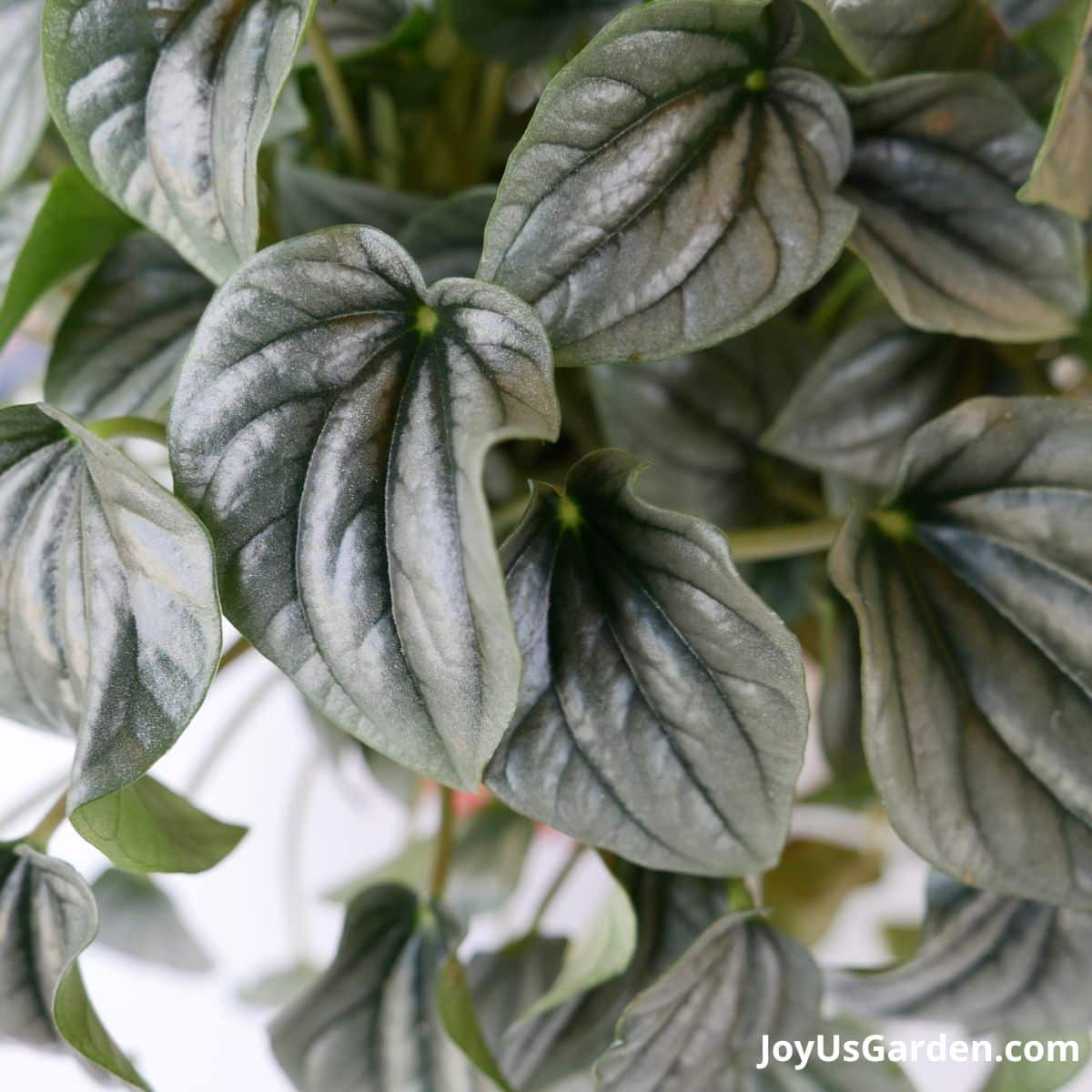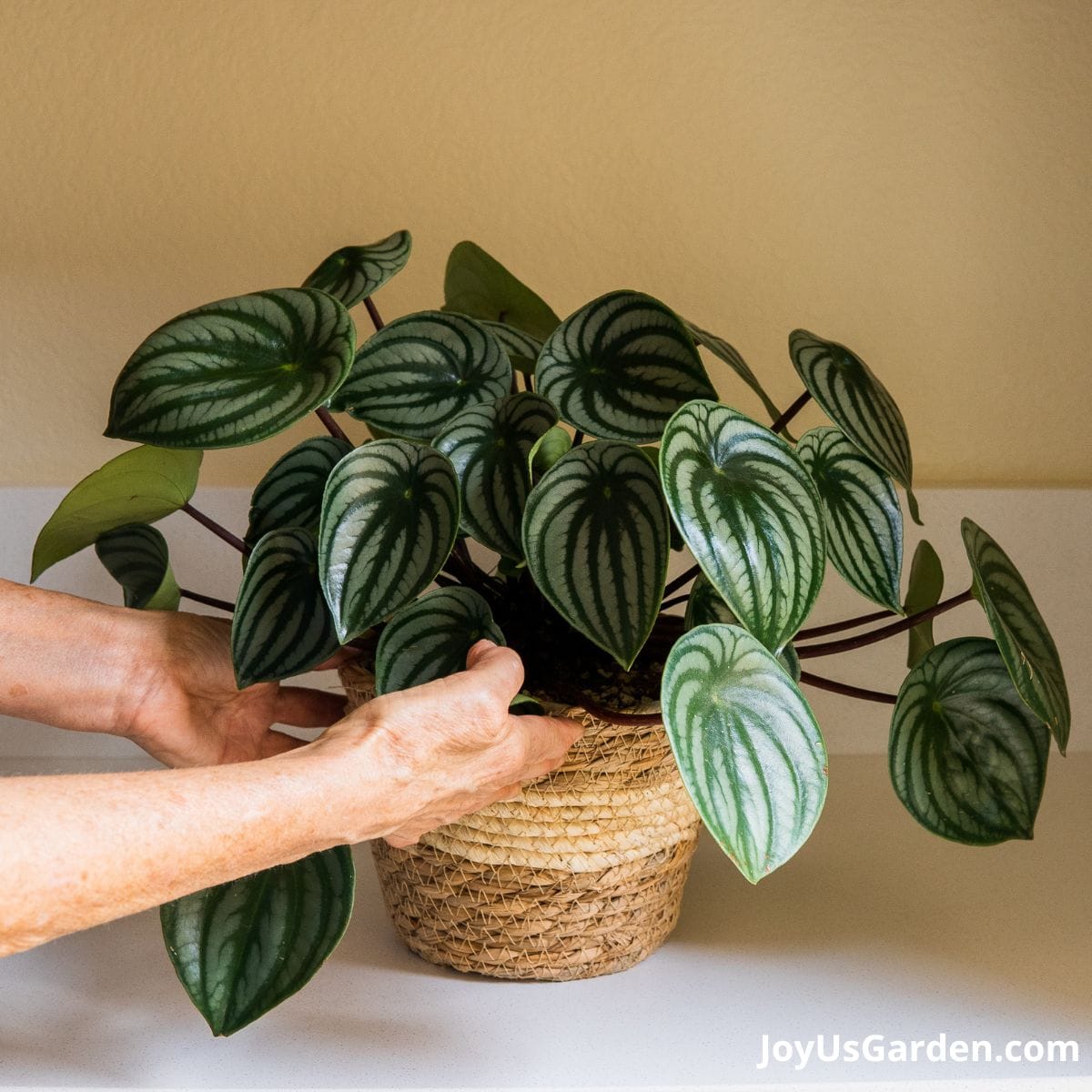Ripple Peperomia: Peperomia Caperata Care
If you’re in the market for a compact houseplant that’s as sweet as can be, here’s the one for you. This is all about growing a Peperomia caperata or Ripple Peperomia.
Mine sits on the kitchen counter and doesn’t take up much space at all. I love the form, shape, and texture of this easy-care plant. I have 50+ houseplants and many of them outgrow their pots in no time. That’s another reason I love this plant – it doesn’t need frequent repotting and you gotta love that!

The one you see here is the Silver Ripple Peperomia. The Emerald Ripple Peperomia and Red Ripple Peperomia are different Peperomia varieties within the caperata species. They’re very popular too. This growing guide applies to all the Ripple Peperomia plants.
Ripple Peperomia Traits
Size
This Peperomia is one that stays relatively petite. They’re commonly sold in 4″ and 6″ grow pots. I’ve had mine 3-4 years now and it’s still in the 6″ grow pot I bought it in.
My Silver Ripple is now 9-10″ tall x 15″ wide.
As they grow, the foliage gets very dense and forms a beautiful mound.
Growth Rate
This is in general a slow grower. Here in sunny, warm Tucson, many of my indoor plants grow fast. This is a slow to moderate growing plant for me.
For me, this is an advantage. I won’t need to find a spot with more room to move it to, buy a larger decorative pot for it to go into, or do any pruning to control the size.
Uses
This is a tabletop plant. It doesn’t take up a lot of room so you can squeeze it in almost everywhere. Its small size makes it suitable to be an office plant.
Why is this plant popular?
The rippled, crinkly heart-shaped leaves and the attractive form!
Here are posts & videos on Peperomias you’ll find helpful. Watermelon Peperomia Care, Peperomia Obtusifolia Care, Peperomia Care, Repotting Peperomia Plants, Propagating & Pruning Baby Rubber Plant, & How to Plant Baby Rubber Plant Cuttings.
Ripple Peperomia Care Video Guide
Peperomia Caperata Care
Light/Exposure
Mine is growing in all-day bright indirect light. It’s 4′ away from a north-facing window in my kitchen and receives no direct sun but a hefty amount of indirect sunlight in the morning.
It grows next to a wall so I rotate it every now and that natural light hits all sides of the plant.
This is a plant that can tolerate lower light levels but does best in moderate light. If the light is too low, it means no growth. If in the hot sun, it’ll burn.
You may have to move your Ripple Plant to a brighter spot in the darker winter months so it gets the light it needs.
Caring for indoor plants in winter is different. Here are tips on Winter Houseplant Care.

Watering
I can’t tell give you a watering schedule because variables come into play like pot size, soil mix composition, the location where it’s growing, and your home’s environment.
In general, water your Ripple Peperomia when the soil is 3/4 of the way dry. In the summer months, you’ll have to water more often, and in the winter months, less often.
Because there’s a lot of sun, heat, and lack of humidity here in the Sonoran Desert, I water mine every 5-6 days in the warmer months. In winter, it’s every 7-12 days. You may not need to water yours as often depending on what climate you’re in.
The thick leaves and fleshy stems store water. Don’t keep the soil consistently wet as that will lead to soggy stems and root rot.
It’s best if the bottom of the pot has 1 or more drainage holes so the excess water can flow out.
If the plant isn’t receiving enough water, the plant will droop. To confuse matters, the plant will droop if given too much water.
I always use room temperature water for my indoor plants.
If you’re new to indoor gardening, you’ll want to check out our Guide to Watering Indoor Plants.
Temperature
If your house is comfortable for you and everyone else, it’ll be so for your indoor plants too.
Be sure to keep your Peperomia away from cold drafts as well as any blasts from air conditioning or heating vents.
Humidity
Peperomias are native to subtropical and tropical regions so they prefer humid conditions. Despite this, the ones sold in the houseplant trade are mostly adaptable when it comes to humidity. Even though this plant would prefer high humidity levels, it handles the drier air in our homes like a champ.
Sometimes the humidity levels here in Tucson range from 11-20%. Dry to say the least and my Ripple Plant is doing and looking great!
I have a humidity reader in my living room/dining room. It’s simple, cheap, and gets the job done. I run tabletop humidifiers when the humidity is below 30%, which is a good deal of the time here in Arizona.
I also give all of my Peperomias a shower in the kitchen sink every month and put them outside a couple of times when the summer monsoon rains roll in.
If you think yours is stressed in regards to humidity, you can also try filling a saucer with small rocks and water and putting your plant on top of it. Just make sure the drain holes aren’t submerged.
You can also mist your Peperomia a couple of times a week.
I live in the Sonoran Desert. This is how I Increase The Humidity (or try to!) for my houseplants.

Fertilizer
The best times to feed your indoor plants are spring and summer. Into early fall is fine if you’re in a climate with temperate winters like me.
Every other spring I give my houseplants (except air plants, bromeliads, and orchids) a little application of worm compost/compost. Be careful not to use too much, a 1/4″ layer for a 6″ pot will be fine. It breaks down slowly and works into the soil every time you water so it’s a great way to nourish the soil.
I give my Peperomias a watering with Eleanor’s VF-11 3 or 4 times during the warmer months. Online orders of this product are delayed now because of the 2022 supply chain issue but keep checking back if you can’t find it locally.
I’ve subbed Grow Big for Eleanor’s and have been happy with that so far.
Alternately, I feed with Maxsea 3-4 times per year also. We have a long growing season here so my potted plants need and appreciate the nourishment.
Other options would be this kelp/seaweed fertilizer and Joyful Dirt. Both are popular and get great reviews.
Feeding twice a year with a balanced fertilizer may be enough for your Peperomia depending on your growing season.
Don’t overfertilize (use too much a ratio or do it too often) because many fertilizers are high in salts which can eventually burn plant roots.
Here’s some more info on how I Feed my Indoor Plants.
Soil/Repotting
It’s the same as with fertilizing and feeding, spring, summer, and early fall are the optimum times for repotting plants.
Their root system is small just like the plant. Ripple Peperomias don’t need repotting often (every 4-6 years if not stressed from being potbound) as they stay compact and don’t grow fast. In regards to a bigger pot, only go up 1 size. For instance, from a 4″ grow pot to a 6″ grow pot.
I use a potting mix in a 1:1 ratio of potting soil to DIY Succulent and Cactus Mix. This ensures the soil mixture has good drainage and helps to prevent soggy soil which helps to prevent root rot.
The DIY succulent mix contains coco chips and coco coir (a more sustainable alternative to peat moss) which Peperomias love. I also throw in a few handfuls of compost and top with worm compost for some extra goodness.
You’ll also find alternative soil mixes suitable for peperomia repotting in this post.
You can check out this post and video on Peperomia repotting for more details and the step-by-step on how to do it. We’ve also done a Basic Guide To Repotting Plants.
Pruning
Not much is needed in the pruning department when it comes to this plant. Once or twice a year I snip off a few dead or dying lower leaves and that’s about all I do.
It doesn’t grow outward and trail like its cousin the Baby Rubber Plant. Because it stays compact and tight, there’s no need to get out the pruners. The stems are very easy to pinch off with your fingers.
I do take off the spent flower stalks, but they easily come right off.

Propagation
I’ve never propagated a Peperomia caperata, but I have the Peperomia obtusifolia (Baby Rubber Plant) by stem cuttings and also division.
You can propagate a Ripple Peperomia by stem cuttings in water. I’ve read you can also propagate it by leaf cuttings but it can be hit or miss. Dividing the plant might be an option, but it grows so densely and the root ball is small, so I imagine it would be tricky business to get an even divide.
The Peperomia obtusifolia propagates very easily. This is how I propagated my Baby Rubber Plant.
Pests
My Peperomias have never gotten any pests. I imagine they could be prone to Mealybugs because of their fleshy leaves and stems. Also, keep your eyes out for Spider Mites.
The best way to help keep pests at bay is to keep your plant healthy. A stressed and/or weak plant will be more susceptible to pests.
Pests can travel from plant to plant fast and multiply overnight so make sure to check your plants regularly so you get those pests under control as soon as you spot them.
Pet Safety
Wave the pom poms! The ASPCA website lists this Peperomia as non-toxic to cats and dogs.
Flowers
Yes, they do but don’t look for anything big and showy. The flowers are tiny, green, and appear in clusters on the ends of fleshy stems. I’ve seen them referred to as mouse tails and if you look at the photo below, you can see why.
If your Peperomia caperata is healthy and happy, it’ll flower.

Ripple Peperomia Care FAQS
This is a small plant. I’ve had mine for 4 years now and it’s 10″ tall by 15″ wide. I love that it stays compact unlike many of my other indoor plants. No need for frequent repotting!
Technically, no. But the fleshy leaves and stems make it succulent-like.
Those green spikes are actually the flowers. You can see one in the photo above.
This tropical plant would love to be misted! Misting weekly would be a good idea.
I can’t give you a watering schedule because I don’t know the growing conditions and there are so many variables involved. In general, water yours when it’s 3/4 of the way dry. It’ll tell you if it’s unhappy!
If it goes completely dry and needs water, the leaves and stems will droop down. Mine dried out a few weeks ago and went limp. I caught it right away and it recovered fine. If yours stays dry for too long, it probably won’t recover.
The leaves should feel smooth and firm yet slightly fleshy. If the leaves and stems are soft, your plant could be too dry. To make things confusing, soft leaves could indicate too much water also.
The most common reason is watering issues. Following right behind it is exposure.
Consistently moist soil will lead to rot yet you don’t want to soil mix to dry out for too long.
They tolerate low light levels for a while but do best in natural bright light.
Heads up plant lovers – Ripple Peperomias are sweet as can be and so easy to grow. This is a great houseplant addition to your collection!
Happy gardening,






